Rowton House — Whitechapel
In 1892, a new type of hostel for down-and-out or low-paid working men appeared in London — the first of the Rowton Houses created by philanthropist Lord Rowton. His aim was to provide a cheap accommodation that was better and cleaner than anything else available at the time. An overview of Rowton's scheme is given on a separate page.
The first Rowton House, at Vauxhall, which opened in December 1892, was personally financed by Lord Rowton. Following its success, a limited company was formed to expand the scheme. The Whitechapel Rowton House, on Fieldgate Street, was the fifth to be built — it opened on 11th August 1902 and provided 816 beds. The location of the site is shown on the 1916 map below.
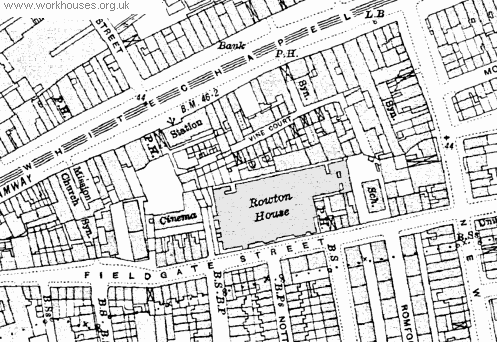
Whitechapel Rowton House site, 1916.
Rowton Houses were all constructed along the same basic lines. The ground floor and basement contained the entrance hallway, dining room, smoking lounge, reading room, washrooms, barber's shop, shoemaker's and tailor's rooms, clothes and boot cleaning rooms, parcels room etc. The upper floors contained large numbers of private cubicles each of which contained a bed, chair, shelf, and a chamber pot. Residence in the establishment cost 6d per day although no access to the cubicles was permitted during the daytime. Lodgers could either buy meals in the dining room or cook their own food, also obtainable from a shop in the dining room.
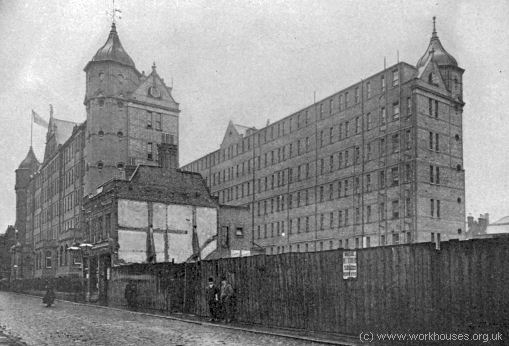
Whitechapel Rowton House from the east, 1902.
© Peter Higginbotham.
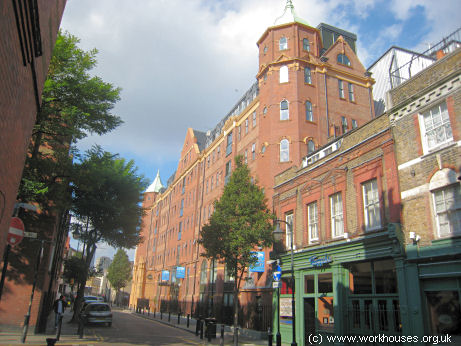
Whitechapel Rowton House from the east, 2007.
© Peter Higginbotham.
A description of the Whitechapel Rowton House from 1902 described it as the most palatial built to date:
For administrative purposes the building is divided into five sections: — 1, superintendents' apartments with separate accommodation for office clerk; 2, bed-makers; 3, catering section. which includes sleeping accommodation for females employed in shop, kitchen, and scullery; 4, lodgers' day rooms; and 5, lodgers' cubicles. The sections 1, 2, and 3 are planned so that there is no communication whatsoever between them and the lodgers' section 4 and 5 except by passing in view of the clerk's office at the entrance on ground floor.
The superintendents' apartments comprises a self-contained residence of two storeys, with a front entrance door next to the entrance door of an office which is immediately to the left inside the entrance doors, and a bedroom for the clerk which adjoins the office, and is approached by a private staircase. The section used by the bed-makers (female day servants) is approached by a gate at the foot of the staircase next to the entrance. The apartments include a sitting room, provided as a dining room, a soiled linen room, and a linen and blanket room.
The catering department is situated on the ground floor, and is approached by a corridor from the superintendents' section. Complete arrangements are made for the preparation and sale of cooked or uncooked foods, or for the sale of food to those lodgers who may prefer to cook their own. The catering is carried out by the company's own staff, under the supervision of the superintendent. The accommodation includes a kitchen, scullery, larder, stores. and a set of apartments (sitting room, six bed rooms, &c.) for the kitchen servants.
Section 4 (the lodgers' day rooms, &c.) is perhaps the most interesting portion of the building. It includes a smoking room, reading room, dining room, lodgers' scullery, locker rooms, smoking lounge, lavatories, barber's shop, feet washing, bath, and dressing rooms, shoemaker's and tailor's rooms, clothes and boot cleaning rooms, parcels room, &c. All the rooms are beautifully fitted up, and one cannot help being struck with the air of comfort which pervades the whole of these rooms. The smoking room has a floor space of 1,936ft. Tables and chairs of teak are provided, and, as fitted, will seat 140 lodgers. The reading room is somewhat larger. Its floor area extends to 2,442ft., and it has accommodation for 168 men. A striking feature of this room is a series of panels emblematic of "The Seasons," which occupy a large portion of the wall space. These panels have been specially painted by Mr. H. F. Strachey, of Stoney Mead, Clutton, near, Bristol, and have been most generously presented to Rowton House as a practical demonstration of the interest taken by the artist in the elevating work of a Rowton House. Each season is represented by a single figure and also by a larger composition, while over the fireplace in the middle is a small allegorical work — a symbolical figure of England sits enthroned, while the fruits of the land are brought to her by the cultivators. The dining room, of course, is the largest of the lot. It has a floor space of 5,891ft., and seating accommodation is provided at tables for 456 men. It is extremely well lighted and ventilated, and is provided with four large cooking ranges, with ovens, hot plates, and grills.
The lodgers' cubicles occupy the largest portion of the building. There are altogether five floors of these cubicles, with a total sleeping accommodation for 816 men. Each bed is in a separate cubicle, and every cubicle in the building has a window under the control of the occupant. The bedsteads are of iron, and are fitted with wire woven mattresses, a horsehair mattress and bolster, blankets, sheets, and quilts, and each cubicle is provided with a chair, shelf, clothes, hooks, and utensil. The charge for each cubicle, with the use of the day rooms, lavatories, &c., is 6d. per night.
The whole establishment throughout will be kept scrupulously clean, and at present it looks particularly bright and comfortable. Altogether it should prove a very great boon to the many poor men — and there are a very great many in Whitechapel — who find a difficulty in securing a cheap and comfortable night's lodging.
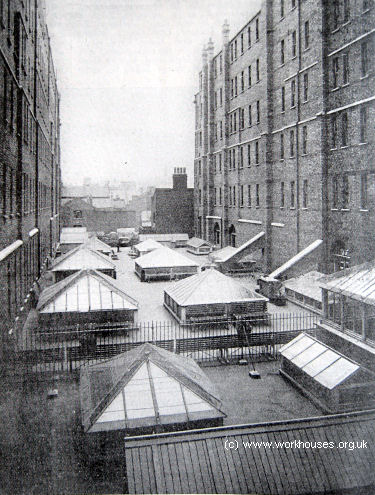
Whitechapel Rowton House inner courtyard, 1902.
© Peter Higginbotham.
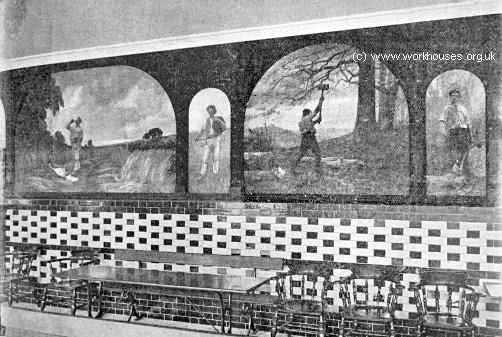
Whitechapel Rowton House reading room — part of The Seasons, 1902.
© Peter Higginbotham.
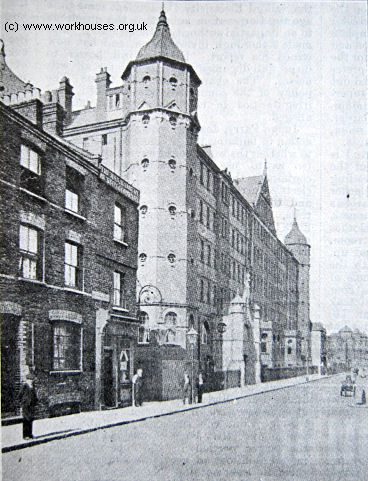
Whitechapel Rowton House from the south-west, 1902.
© Peter Higginbotham.
In 1907, Joseph Stalin and Maxim Maximovitch Litvinov (a Jew who later became Stalin's Commissar of Foreign Affairs) spent two weeks at the Whitechapel Rowton House whilst attending the Fifth Conference of the Russian Social Labour Democratic Party. The writer Jack London also encountered the establishment in 1902 when he was staying incognito in the East End of London. London later wrote: "The poor man's hotel," they are often called, but the phrase is caricature. Not to possess a room to one's self, in which sometimes to sit alone; to be forced out of bed willy-nilly, the first thing in the morning; to engage and pay anew for a bed each night; and never to have any privacy, surely is a mode of existence quite different from that of hotel life."
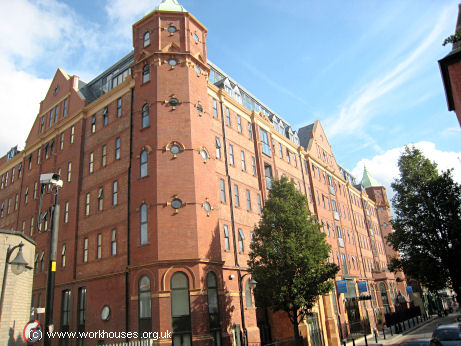
Whitechapel Rowton House from the south-west, 2007.
© Peter Higginbotham.
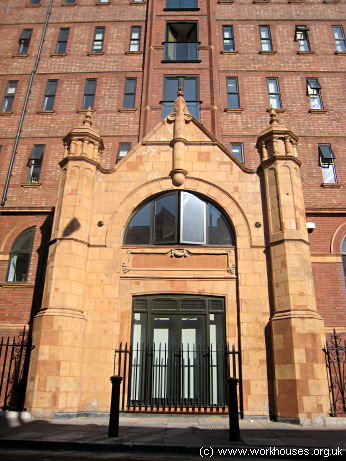
Whitechapel Rowton House entrance, 2007.
© Peter Higginbotham.
The Whitechapel Rowton, also known as Tower House, has recently been refurbished for residential use.
Other Rowton Houses
The other Rowton Houses in London were:
- Vauxhall — opened 31st December 1892
- King's Cross — opened 1st February 1896
- Newington Butts — opened 3rd December 1897
- Hammersmith — opened 2nd December 1899
- Camden Town — opened 7th December 1905
A number of Rowton-style hostels were also opened outside London, such as the Birmingham Rowton House in 1903.
Bibliography
- Cornes, James (1905) Modern Housing in Town & Country (London: Batsford)
- Farrant, Richard (1904) Lord Rowton and Rowton Houses in Cornhill Magazine, June 1904.
- Sheridan, Michael (1956) Rowton Houses 1892-1954 (London: Rowton Houses Ltd)
Links
- None.
Unless otherwise indicated, this page () is copyright Peter Higginbotham. Contents may not be reproduced without permission.


